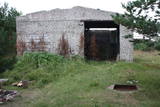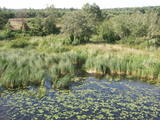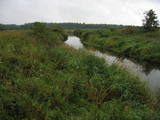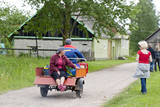| Nr | Nosaukums | Apraksts |
|---|---|---|
|
Piedāvājumā ir zirgu izjādes un izbraucieni pajūgā visa gada garumā. Apmeklētāji var rast saskarsmi ar dzīvniekiem – kazām, aitām, vistām, tītariem, zosīm un pīlēm. Kūpināta kazas siera degustācija. Saimniece taisa ziemassvētku puzurus u.c. rotājumus. |
||
|
Labraga krasta robežapsardzības punkta vietā mūsdienās ir saglabājušās divu prožektoru ēku paliekas. Tās atrodas stāvā Baltijas jūras stāvkrasta malā - daudz tuvāk jūrai, nekā padomju laikos. No tā izriet, ka pārredzamā nākontē tās tiks noskalotas. Objekts atrodas privātīpašumā.
|
||
|
Netālu no augstākā Latgales augstienes paugura – Lielā Liepukalna atrodas zemnieku saimniecība, kuras darbnīcā amatnieks Jānis Kuzminskis taisa mūsdienīgas ģitāras u.c. mūzikas instrumentus. Apmeklētāji var iepazīt Jāņa veidoto ekspozīciju, vērot amatnieka darbošanos, pasūtīt sev jaunu instrumentu, kā arī muzicēt pie bagātīgajā kolekcijā savāktajiem instrumentiem. Saimniece stāsta par Latgales kulinārā mantojuma ēdieniem un rāda, kā gatavo gulbešnīkus. |
||
|
Atrodas Vaiņodes, Aizputes, Uzvaras un Zviedru vārtu ielu krustojumā. Zviedru vārti ir Priekules simbols, kas attēlots pilsētas ģerbonī. Vārti (1688. g., restaurēti 1954. g.) kalpojuši kā Priekules muižas caurbraucams vārtu sardzes tornis, kur notika to tirgotāju kontrole (muita), kas devās uz vai no Lietuvas. Ar šeit iegūtajām nodevām tika papildināta barona Korfa kase. Interesants ir 18. gs. no Gotlandes smilšakmens tapinātais baronu Korfu dzimtas ģerbonis ar sudraba lodi virs tā un maskaronu vārtu centrālajā fasādes daļā. Teikas vēsta, ka vārtos iemūrēti dārgumi un sākas pazemes eja. Baronu laikos vārtu abu pušu nišās stāvēja draudīga izskata divmetrīgi no akmens darināt sargi – zaldāti. Līdz pat 2. Pasaules karam pastāvēja ticējums, - ja zaldātiem nobučo nabu, bučotājs piedzīvos laimīgu dzīvi. Tagad pie vārtiem stāv no koka darināti sargkareivji. No Zviedru vārtiem redzama Priekules pils un skatu tornis. |
||
|
Viens no populārākajiem Latgales tūrisma objektiem. No lielpaugura plakanās virsotnes (247 m vjl, ap 60 m virs tuvākā apkārtnes) paveras viena no skaistākajām Latgales ainavām un redzams 2 km attālais Rāznas ezers. Mākoņkalnā atradās 13. gs. celtā un praktiski neieņemamā Livonijas ordeņa Volkenbergas pils, - viens no pirmajiem Latgales nocietinājumiem, no kuras līdz mūsdienām saglabājušies tikai pils mūra fragmenti. Mākoņkalna pakājē atklāta piemiņas plāksne, kas vēsta par Latvijas pirmās brīvvalsts prezidenta Kārļa Ulmaņa Latgales apmeklējumu 1938. gadā. |
||
|
Mākslinieka un koktēlnieka Antano Česnulio koka skulptūru parks atrodas Naujasodė ciematā, aptuveni 3 km attālumā no Druskininku pilsētas. Ekspozīcija tiek regulāri atjaunota ar jauniem darbiem. |
||
|
Meklējams Zirgu salas dienviddaļā – uz t.s. Golodova dambja. Tornis pieejams kājāmgājējiem un velobraucējiem. Automašīna jāatstāj pie Ezermalas ielas. No torņa redzams plašs skats uz daļēji aizaugušo Liepājas ezera ziemeļdaļu. Laba putnu vērošanas vieta. Ietilpst Liepājas ezera dabas lieguma teritorijā. |
||
|
Pavasaros Lielupes palos regulāri aplūstoša teritorija – palieņu pļavas un putniem nozīmīga vieta. Teritorija labi pārskatāma no Rīgas – Liepājas šosejas un blakus pieguļošā Kalnciema ceļa. Teritorijā izveidota atpūtas vieta un izvietoti informācijas stendi. |
||
|
Viena no vecākajām Latvijas pilsētām, par kuru ziņas ir atrodamas jau no 1378. g. Kā apdzīvota vietā tā izveidojās Tebras krastos (Rīgas-Prūsijas ceļa mala), kur savulaik atradusies kuršu zemes Bandavas nocietināta koka pils Beida. Viduslaikos Aizpute bija Kurzemes bīskapijas centrs. Pēc Kurzemes pievienošanas Krievijai 1795. g., Aizputē uz dzīvi apmetās ebreji. Šodien ceļotājus Aizputē visvairāk piesaista saglabājusies senā pilsētvide, pilsētas vēsturiskais centrs un pilsdrupas. |
||
|
Piemiņas vieta ar pieminekli (atklāts 1936. g., tēlnieks: K. Zāle) 1. pasaules kara laika kritušajiem 38 karavīriem Smārdē pie Smārdes – Tukuma ceļa. No 1915. – 1917. g. frontes līnija atradās netālu no Smārdes. Kritušo bija daudz, tādēļ tie tika apbedīti turpat purvā. Tikai pēc kara tos pārapbedīja Smārdē, Kūdrā, Ķemeros un Slokā. |
||
|
Pirts Muzejs ir privāts brīvdabas muzejs, kas dibināts 2008. gadā. Tas atrodas 40 km no Rīgas pie Murjāņu - Saulkrastu ceļa. Pirts Muzeja ekspozīcija sastāv no sešām vēsturiskām un vienas jaunuzceltas pirts. Tās visas darbojas, taču saimnieki īpaši iesaka izbaudīt melno pirti. |
||
|
Atrodas Sabiles centrā. Bistro tipa ēdināšanas vieta, kas piedāvā maltīti steidzīgajiem. Sadarbojas ar apkaimes zemnieku saimniecībām. |
||
|
Skaisti un iespaidīgi skati, īpaši – agrās rīta stundās uz Alūksnes vēsturiskajām vietām paveras no Tempļa kalna, Aleksandra paviljona, obeliska H. Fon Fītinghofa piemiņai un pieminekļa 7. Siguldas pulka karavīru piemiņai apkārtnes. Tempļa kalns, pilsdrupas, muiža un paviljons - kultūras pieminekļi.
|
||
|
Palieņu pļavas starp Rūjienu un Rūjas ieteku Burtnieku ezerā, kurām raksturīga liela augu un putnu sugu daudzveidība. Tās robežojas ar bijušiem Rūjas zivju dīķiem, kas šobrīd aizaug ar mežu. Rūjas palienes var vērot gan braucot ar laivu pa Rūju, gan arī no ceļa, kas ved uz minētajiem dīķiem. Tur izvietots informācijas stends.
|
||
|
Skatu tornis uz pontoniem, kuru ar sauszemi savieno laipa. No tā praktiski pārskatāms viss Slokas ezers līdz pat Kauguriem, īpaši tā ziemeļdaļa. Pie torņa meklējams sēravots. Piemērots putnu vērošanai visa gada garumā, t.sk. ziemās, jo ezerā saglabājas neaizsalstoši lāsmeņi. |
||
|
Ceļojumā apskatīsiet slaveno Lietuvas Krusta kalnu, Kauņas vecpilsētu, no skatu vietām vai izbraucot ar kuģīti vērosiet krāšņās Nemunas upes lokus. Kūrortpilsētā Druskininkos apmeklēsiet Grūtu parku ar “ļeņinekļiem”, piedzīvojot aizgājušos „Padomju laikus”. Iespēja izvizināties ar velosipēdu pa vienu no visneskartākajām dabas teritorijām Baltijā Dzūkijas nacionālo parku. Vakarā varēsiet baudīt kādu no izvēles SPA procedūrām vai izpriecāties lielajā Druskininku ūdens atrakciju parkā. |
||
|
Pīrissāre ir 7,5 km² liela pastāvīgi apdzīvota Peipusa ezera sala. Pārsvarā šeit uz dzīvi ir apmetušies krievu vecticībnieki, kas vairākus gadsimtus rūpējas par savas savdabīgās kultūras saglabāšanu. Iedzīvotāji galvenokārt nodarbojas ar zvejniecību. Uz lauksaimniecībai piemērotas zemes audzē dārzeņus, visvairāk – sīpolus. Uz Pīrisāri no Lāksāres ostas var nokļūt ar prāmi "Koidula" (tālr.: +372 527 2974, www.veeteed.com). |
||
|
Saimniecības laukos ganās ap 300 aitu kupls ganāmpulks, no kura iegūst gaļu un vilnu. Piedāvā ekskursiju, kurā stāsta par aitu audzēšanu, cep maizi, auž un uz ugunskura vāra zupu. Apmeklētāji var iegādāties adītas zeķes, cimdus, segas, lakatus, galdautus un citas saimniecībā noderīgas lietas. Stāsta par atjaunotās mājas vēsturi un kopj latviskās tradīcijas. |
||
|
Viens no diviem nacionālā parka skatu torņiem, kas atrodas ~ 1,5 km ziemeļos no Ehijerva ezera (Ähijärv). Tornis ir veiksmīgi „nomaskēts” nelielā priežu pudurī, tādēļ tas „nebojā” izcilo dabas un kultūrainavu, kas paveras no tā skatu platformas. Pie autostāvlaukuma ir izveidota labiekārtota atpūtas vieta. |
||
|
Valsts Stendes selekcijas stacija dibināta 1922. gadā un atrodas Ziemeļkurzemes augstienē - Talsu rajonā, Lībagu pagasta Dižstendē. Valsts Stendes graudaugu selekcijas institūts veic zinātnisko darbu graudaugu selekcijā, laukkopībā un citās konvencionālās un bioloģiskās lauksaimniecības jomās.
Apmeklētājiem piedāvā no graudiem gatavotu produktu degustāciju Valsts Stendes graudaugu selekcijas institūtā.
|
||























